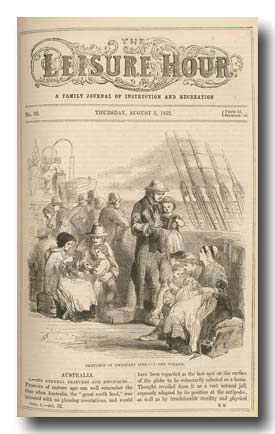
Immigrant shipping: The route
The route
The route sailed didn't change very much until the last decades of the 19th century: the English Channel and the Bay of Biscay, both with their notoriously rough weather had first to be negotiated whether the ship was sailing from an English or a Hanseatic (German) port. Once the tropics were reached the weather improved, providing more opportunity for the passengers to enjoy the open air, but if the ship was trapped in the doldrums, it would be many weeks of windless air and heat, and a monotonous heaving sea that had to be endured; tempers frayed and violence could ensue.
Delays in the doldrums also placed a strain upon provisions, especially water. The ship might be forced to call at Rio de Janeiro, or Cape Town to restock.
Whatever the fortunes of a quick passage, or slow, once through the tropics the ships always steered well to the west in the south Atlantic, towards the South American continent, in order to pick up the winds and get below South Africa and then find the Roaring Forties, which would take the ship speedily across the Indian Ocean to its Australian landfall. High seas were a feature of these latitudes and icebergs might be seen, or worse encountered, if the captain steered too far south. There are records of ships being damaged in the winds, but not of ships being lost. Worst for the passengers though was that usually the hatchways would be battened down in the high seas - this made conditions below decks uncomfortable in the extreme.
Arrival
For South Australian emigrants, the first sight of Kangaroo Island meant the end of the voyage was nearing. Normally it would take only a few hours to travel up Gulf St Vincent to Port Adelaide, but if the winds were contrary it would take much longer, and frustrate both captain, crew and passengers. After months at sea, land was finally in view, but what did they see: low lying cliffs on the Yorke Peninsula side of the gulf, if winds or poor navigation sent the ship that way, or perhaps it was the high cliffs of the lower Fleurieu Peninsula that was the first view of the passengers' new home. It was only as they reached higher up the gulf, that the land became lower and more open to view - and if it was midsummer or early autumn it might have looked dry. The earliest landings after those at Nepean Bay were made at Glenelg; passengers and their goods would all be rowed ashore in ship's boats and landed on the beach, from where they could follow the track to the main settlement at Adelaide.
However, Glenelg or Holdfast Bay was not a port. The colony's designated port was Port Adelaide and the first ship of immigrants to be landed there was the John Renwick, 9 February 1837. The original landing place was higher up the river than the present Inner Harbor, adjacent to the Birkenhead Bridge; however this was where the ships moored and then the passengers and their goods were taken further upstream to the landing place, where passengers then forced their way through the mangrove swamp and over several sand hills to a small settlement - an unsatisfactory start to a new life. By February 1838 a small cutting or canal and a wharf had been constructed, but conditions did not improve much until October 1840 when McLaren Wharf was opened in the New Port or Gawler Reach area (adjacent to Birkenhead Bridge). A new road to Adelaide was also built by the South Australian Company.
Getting to Adelaide itself was the next problem. A railway was not built to the Port until 1856. In the meantime new immigrants walked, or if they were able to afford it, hired a drayman to carry them and their luggage up to Adelaide. That walk was either dry and dusty, or muddy if it had rained. At the end of the walk they might arrive at Emigration Square near the corner of North and West Terraces. Here during the late 1830s and 1840s immigrants could find accommodation in tents and rough dwellings under the supervision of the emigration agent, while they searched for work and housing. Later, immigrants were able to remain aboard ship for up to a fortnight while this search for more permanent residence was made.
Items 1 - 12 of 24













